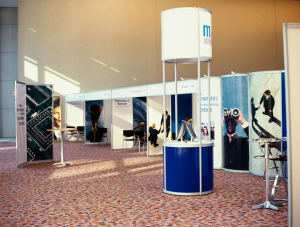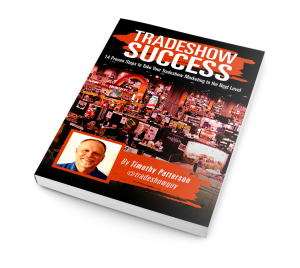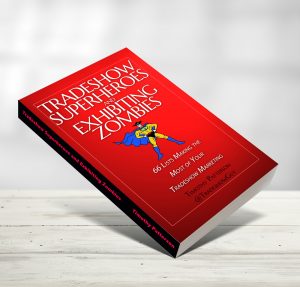Increasing Tradeshow Success Through Awareness
You might think that when I mention “tradeshow awareness” that I’m thinking of how you make visitors aware of your tradeshow booth, so you can draw people in. Sure, that’s important, but that’s not what I’m getting at here.
Let’s look at the other side: the awareness you as a tradeshow exhibitor has. What do I mean?
There are a number of things that, if you’re aware of, can help increase your success.
An Example
Let’s give an example that’s not related to tradeshows. For example, let’s say you want to lose 10 or 15 pounds. Not an unreasonable goal, right? But how does awareness come into play and how does it affect your efforts to lose that weight?
The most obvious way is to be aware of how much we’re eating and how much we’re exercising. And thankfully in today’s digital world, there are a lot of apps that can help you be more aware. One app I’ve used, Lose It!, lets you track calorie consumption, water consumption, and your daily exercise habits. After using it for over a year, not only did I lose the 15-20 pounds I was aiming for, but I realized that the very fact of being aware of my calorie intake and my exercise habits was a big contributor to the success of reaching my goal.
When you eat a cookie, let’s say, if you want to track the calories, you have to know how many calories it contains. Which means you have to look it up. If it’s a package of store-bought cookies, as opposed to home-cooked, the calories per cookie are listed on the package. If a cookie is 150 calories, log it when you eat it.
Same with breakfast, lunch, dinner and any other snacks you have. Once you’ve inputted your data (age, weight, sex, goals, etc.) the app calculates a daily calorie regimen. Stay under the daily allowance, and you’re likely to see your weight slowly drop. Go over the allowance consistently, and you won’t! Easy enough, right?

Then when you exercise, such as take a bike ride or go for a walk, enter that data, and the app calculates the amount of calories you’ve burned. Which means you can either increase your calorie intake or not. You get a visual reminder of everything. It works great.
But the key is awareness. If you weren’t aware of how many calories that cookie contains, you might not care. But now that you’re aware, you realize that each and every bite you take adds to your calorie count. Given that an adult needs approximately 2000 calories a day to maintain an even weight, it’s easy to go over that amount if you don’t count calories. If you’re not AWARE.
How does awareness play into your tradeshow success? Same principle. If you’re not aware of certain things, you won’t be impacted. If you are aware, the simple fact of being aware can likely make a positive impact.
What to Be Aware Of
What things are important to be aware of on the tradeshow floor?
Traffic: I would wager that most people don’t count the number of visitors in the booth at any given tradeshow. They may have a sense that the visitor count in their booth goes up or down year over year, but without an actual count, it’s just a feeling, and not actual data. Imagine if you could know exactly, or within a reasonable number, how many people visit your booth per day, or per hour, or per show.
Engagement: this might be a metric that is a little harder to measure, but if you are aware of what a good engagement with a visitor is, and you work to create better engagement through staff training, demonstrations or sampling, you’ll have a good idea of what outcomes those engagements lead to. Remember, you can’t control the outcomes, but you can control the behaviors that lead to outcomes. If your lack of engagement with visitors keeps your lead generation and engagement low, figure out what it takes to increase visitor engagement.
Leads: lead count is important. But so is the quality of leads. If you collect 300 leads at a show, but haven’t graded them as to hot, warm or cool, your follow-up will not be as good. But if out of those 300 leads, you know that 75 are HOT and need to be called within two days of returning from the show, and that 155 are warm and should be followed up within three weeks, and that the final 70 are COOL and need only be put on a tickler file or an email-later list, then the follow-up is going to be more consistent and likely more fruitful.
Booth staff: if you have a booth staff that is trained on how to interact with visitors, and how to be more aware of who’s in the booth, your results can only improve. Booth staff training is one of the key factors to success. Do you have a booth staff that is aware of what they need to do, how they need to do it and, how to engage with visitors?
Competition: awareness of competition may seem secondary to your company’s immediate success at any given tradeshow. But look at it this way: you have a lot of competitors at a show. The more aware of who they are, how they present themselves, what products they have (what’s new and what’s not) and the way those products are branded, the more well-informed you’ll be about the state of your competition. In a sense it can be a bit of a SWOT Analysis (Strengths, Weaknesses, Opportunities, Threats) from the floor of a tradeshow. If you’re good at gabbing, you can pick up all sorts of insights about competitors: personnel changes, strength of company, management moves, new products and so on. After all, every exhibitor is showing off their best and latest, and if you’re not aware of your competition, don’t you think its time you paid more attention?
Finally, awareness of how your actual exhibit looks compared to your competition. Gotta say it: everyone compares their exhibits to their neighbors and competitors. How does yours stack up? Is it normal, staid, complacent, expected? Or is it sparkling, engaging, new and different than others?
Awareness is critical to success in so many areas of our lives. Being aware of how things are working on a tradeshow floor is one of those things. Awareness will naturally help you make better decisions and as a result, show more success for your efforts.









